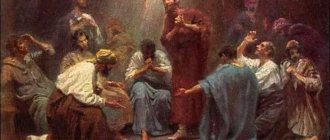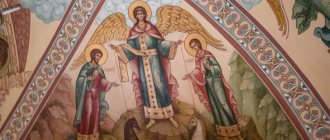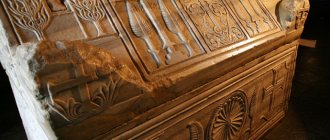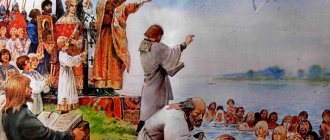Why are Jewish temples called synagogues?
Despite the fact that the conquest of the Promised Land by the Jews took place under the leadership of one commander, Joshua, whose powers were confirmed by Moses himself, a single state did not develop here and the unification of the country happened only centuries later.
The main symbol of this unity was the Temple of Jerusalem, built by King Solomon himself about three thousand years ago. It was believed that every Jew, regardless of the place in which he lived, should conduct the main rites of his religion here, because it was in the Holy of Holies, the farthest room of this building, that the Lord appeared to the high priest, who declared his will to the Israeli people.
In 586 BC. Solomon's temple was destroyed by the troops of King Nebuchadnezzar, and most of the Jews were taken into Babylonian captivity. But just a few decades later, the Persian king Cyrus, who conquered the entire Middle East, gave the believers his blessing to build a new shrine, and even threw in some money.
The second temple was no worse than the first and almost as holy, although many important artifacts of the Jewish religion were stolen by the Babylonians. It was reconstructed several times and served the Israelis for many more centuries, until its destruction in the year 70 by the troops of the Roman commander Titus, who would become emperor in the future.
In the Jewish understanding, the Jews can have only one temple, and it should only stand in Jerusalem, in a strictly defined place, which, as it were, is currently occupied by a Muslim mosque. Either the Messiah or the angels must build a new one, and while it is not available, there is no need to make sacrifices. But no faith can do without houses of prayer, and therefore the Jews also have them. Everyone knows that the place where Jewish worship is held is traditionally called a synagogue.
The first synagogues, according to archaeological and written evidence, appeared in the era of the Second Temple, i.e., when some of the Jews were already settled far from their original homeland and had no opportunity to offer prayers in a public place. Initially, they did not enjoy special authority and were a kind of democratic alternative to the Temple, which not every believer could visit.
Many of them were built as ordinary residential buildings and only later were converted into meeting houses. Over time, their status increased - the Pharisees known from the Bible preached there, as well as Jesus himself and his apostles. One of the first synagogues known to us was built in the city of Ostia - the sea gate of great Rome.
Since the existence of synagogues was not provided for in the Pentateuch of Moses, which was the basis of the Jewish religion, no specific word was developed for the building where believers gather to pray. It could be called in Hebrew - mikdash meat, i.e., “small sanctuary”; in Greek - sabbateion, i.e. “Sabbath house”, in Latin - ekklesia, i.e. "church". But since the ancient world was mainly Greek-speaking, over time the Hellenic word synagogue, which is quite tritely translated as “assembly,” became established.
However, back in the Middle Ages, European Jews used the common Western word schola to designate the place where they came to pray, i.e. school, which meant exactly that. It is quite preserved in Yiddish in the form of “shul”.
However, in modern Judaism, another name is generally accepted - bet-ha-knesset, i.e., “house of meeting”, and Jews use the external, essentially Christian name for their own convenience in communicating with other peoples. Since there are no instructions anywhere on how a synagogue should look, on the outside it can be built even in the Baroque style, but on the inside it traditionally repeats the same First Temple...
Source
New in blogs
Jerusalem became the religious center of the Jewish people back in pagan times, as a place for storing unique shrines, which does not contradict paganism. There is no reason to imagine all the kings of Judea, and especially the kings of the United Kingdom - David and Solomon - as monotheists in the modern sense, that is, who believed that there is only one god. Consequently, the strengthening of the status of Jerusalem and the Temple itself cannot be considered as a deliberate introduction of monotheism. It was a long and uneven process, the results of which were determined not so much by intentions as by objective reasons.
At the beginning and for a long time, the Temple was not the main place in Jerusalem, since almost all the Davidians, including David and Solomon himself, began construction during their reign not with religious buildings, but with a palace, which simultaneously served as a fortification, or simply with fortifications. Therefore, the construction of the First Temple was a means to strengthen the importance of Jerusalem as a center of power - an important means, it is true, but not an end.
The next significant action to raise the status of Jerusalem was the transfer here by David of the “Ark of the Covenant,” an ancient shrine that testified to the union of the people with their God and the unity of the “tribes.” The shrine was considered by David as a value that simultaneously protected his family-dynasty and tied the tribes of the Israelite Union to it, since they considered it as a talisman that ensured the well-being of the people, or rather, the well-being of the one who owns this talisman. Proof of this understanding of the value of the shrine: “When it was reported to King David, saying: “The Lord blessed the house of Abeddar and all that it had for the sake of the Ark of God,” then David went and triumphantly carried the Ark of God from the house of Abeddar to the city of David” ( 1. Book of Kings II. 6:12,17), that is, to Jerusalem. I wonder how Aveddar reacted to this?
Over time, the concept of a talisman was involuntarily (since the talisman itself and its contents were lost) transferred to its place of residence - the Temple Mount. In this regard, there is a legend that it was here that Abraham was going to sacrifice Isaac.
Judging by the fact that David chose a place outside the territory of these tribes for his residence and storage of the shrine of the Israeli tribes, as well as by David’s desire for expansion, by the fact that his guards were not just anyone, but the enemies of the Jews, foreigners the Philistines, etc. .d., it is clear that David did not strive to be a tribal leader, especially under the control of the priests (remembering the fate of Saul), but the king of as many tribes as possible. Combined with the fact that neither David, nor the then ancestors of the Jewish people, nor, of course, the Philistines, were monotheists in the modern sense (for example, the episode with the statue that David’s wife Michal dressed as David). (1 Samuel I. 19:13), this means that the first Davidians wanted to receive the support of all the gods. The House of David sought to tie all the cults in the territory under its control to the place where it felt safe, including from its fellow tribesmen, and from where it could control the situation. Therefore, Solomon placed images of other gods in the Temple he built, and there were their temples in Jerusalem. It seems that the Temple was first and was considered as a Pantheon - a temple of all gods, more precisely, the main gods of all nearby peoples, and this contributed to its popularity. In general, the Davidids made Jerusalem a religious center insofar as it was controlled by them.
At the same time, Jerusalem became a place of pilgrimage, which was beneficial to him in all respects. “The creation of the tabernacle / tent with the Ark of the Covenant - G.D. / and the introduction of sacred cult paraphernalia helped to establish an inextricable connection between the new center of the cult…. and the cult itself... The most important part of the process of transforming Jerusalem into a religious and cult center was the construction of an altar to the God of Israel in the city. ...Thus, the altar was the property of the king” (2. Part I.C.39). From the Book of Kings II, 24:21 it is clear that the altar was made for a specific sacrifice (“so that the defeat of the people” would cease, i.e. the epidemic). This means that the presence of the tabernacle was not enough and not only an object of worship was needed, but also a cult, preferably permanent. Consequently, the transformation of Jerusalem into a permanent religious center contributed to the development of the religious cult itself. The construction of a permanent altar in addition to a tent with shrines was a sign and at the same time a means of transforming the cult and rituals of the semi-nomadic people, who in everyday life remained the tribes of Israel, into the cults and rituals of a settled people. This was facilitated by the merging of the aliens - the Israelis - with the indigenous inhabitants. The creation of a permanent altar, and especially the Temple, was a means of securing a shrine for the king, and “The construction of the temple served as a symbol of the divine chosenness of the city of David and the king himself” (2.Part I.C.40). “Divine chosenness” means inviolability. The creation of the altar and Temple contributed to the transformation of David and Solomon from tribal and military leaders into heads of state, a structure relatively independent of the tribe. Thus, the transformation of Jerusalem first into a center of power, and then into a permanent religious center, was supposed to rally the subject tribes around the Davidids in all respects.
The statement that thanks to the construction of Solomon’s Temple “Jerusalem was finally established as a city chosen by God, the national religious center of the United Kingdom” (2. Part I P.48) is greatly exaggerated, if only because the United Kingdom was united by a personal union, which was necessary to renew with each new reign, fell apart immediately after Solomon, and in the north the kingdom of Israel always had its own high priest. The process of establishing Jerusalem was very long and the Jerusalem Temple then had competing temples in the Kingdom of Israel and Egypt. The quick and easy fall away of the northern tribes, including due to high taxes and duties, some of which were undoubtedly directed towards the establishment of Jerusalem, shows that economic and social factors were even then more important than ideological ones, because the fall away of the northerners meant that it would be difficult for them to access Jerusalem and its shrines . In addition, the Jerusalem Temple was plundered by Pharaoh Shoshenq (930 BC) shortly after the death of Solomon and could hardly be considered as the most important shrine after that.
In general, neither the policy of the first Davidians nor the presence of shrines created the unique status of Jerusalem and the Temple, but only created the preconditions for this. Just as the faith of David and Solomon in God was not monotheism, so the policies of these kings were not religious in the modern sense. They did not introduce or consolidate any ideology, they only wanted to secure in the most literal sense the protection of the gods for their dynasty, and the status and hierarchy of these gods changed. For Solomon, the Temple was undoubtedly the Pantheon, since Solomon worshiped many gods in it.
The meaning of the Temple and Jerusalem for believers evolved along with the content of the faith itself: from the only Temple where all gods are worshiped, to the only Temple of the only God. This evolution was the main reason for the unique status of the city and the Temple, since it is obvious that in the second case the prestige of the Temple is higher than in the first. At first, the importance of the Temple and Jerusalem increased not so much because the Jews slowly and haltingly moved to monotheism, but because the kings sought to concentrate all cults under their control.
Since the attitude of the real David and Solomon to the Temple was completely pagan, then the more important for Jerusalem and the Temple is the ruler with whom the evolution of the cult of God to monotheism began. Such a ruler was Asa (908-873 BC). He only began the movement towards monotheism: he destroyed only the “image of Astarte”, and “the Heights were not destroyed,” that is, the cult of God was not yet monopolized by the Temple, and under Queen Athaliah (842-836 BC) the main The Phoenician gods were declared patrons of the dynasty. The reasons for the slowness and inconsistency of the movement towards monotheism are the preservation of the tribal and clan structure of the then society and the relative weakness of the royal power and the kingdom as a whole, because of which it was subject to strong external influences.
As already said, the growth of the importance of Jerusalem was facilitated not only by its transformation into the main religious center, but also by the strengthening of state power, of which it was also the center. The reforms of Jehoshaphat (873-849 BC) in the field of governance played a major role in this. In Jerusalem, Jehoshaphat made judges “some of the Levites and priests and the heads of the families of Israel” (1 Chronicles II. 19: 5-8), that is, the city began to be governed by the Temple staff and the heads of the clans. This was a step towards the merging of priestly and clan power, which means, towards the unification of the people around the king and the Temple. Thus began the merger of the state apparatus and the priestly class, and this is a sign and factor in the transformation of the people into a religious community. Consequently, the growth of the importance of Jerusalem is associated with the transformation of a tribal union into a state, and the latter into a religious community. At all stages of this process, Jerusalem was the center of events and, as a result, came to be perceived as the guarantor of continuity. The primary reason for this is the inextricable connection between the palace and the Temple in all respects and at all stages. The common interest of the royal authorities and the priests of the Temple in the elimination of the tribal structure led to their unification, that is, to theocracy. At first the king was the theocrat, and starting with Jehoiada, the importance of the high priests grew. And the priesthood of this Temple, naturally, was interested in this Temple, but this did not mean that other gods were considered false, that is, there was no monotheism yet.
An important stage in the history of the people of Israel and Jerusalem, of course, was the split of the United Kingdom. After this, Jerusalem ceased to serve as the main religious, political and economic center of the entire people of Israel. But ultimately this turnaround benefited Jerusalem and the Temple. I believe that it was now that the Temple began to transform from the Pantheon into the temple of the only God. The beginning of this was, as I said, the actions of Asa, and the continuation was the overthrow of Athaliah, which took the form of a struggle between the gods, that is, a religious struggle. On the initiative of the high priest of the Temple, Jehoiada, Athaliah was executed, the temple of Baal that she had erected (apparently the main competitor of the Temple) was destroyed, its priest was killed, and Jehoiada crowned the young king Joash in the Temple and himself became regent. Then “And the priest / Jehoiada / established watch over the house of the Lord” (1. Kings IV. 11:18), that is, the cult in the Temple came under the control of the high priest, and before, apparently, it was under the control of the king, who decided - who to worship in the Temple and appointed high priests. Following this, Jehoiada made a triple alliance between Joash, the people of Judah and God. It looked like a public mass oath organized by the high priest that the people would not stop worshiping God, or rather, would not stop considering God (let’s call him Adonai, that is, “our lord,” that is, the Lord) as the main Jewish god. Therefore, this act was an oath to guarantee the rights (and income) of the priests of God, and the people were the same ones who destroyed the temple of Baal and killed its priest. In general, all this is the populism and extremism of that time. Thus, now the importance of the priests and thereby the Temple as an organization increased both for the cult of God and for ensuring the power of the Davidians and the unity of the people. But it follows from the Bible that after the death of Jehoiada, Joash (reigned 836-797 BC) returned to the worship of Baal, which means he left the control of the Temple priesthood.
The most important stage in changing and increasing the religious status of Jerusalem and the Temple were the reforms of Hezekiah (727-698 or 715-687 BC). In both versions, he ruled during the period of the death of Israel, the main political and religious competitor of Judea. This determined the directions and methods of Hezekiah's policy.
His reforms were aimed at strengthening the existing situation. To annex the remnants of the northern tribes and religious, and therefore political, centralization to Judah, Hezekiah, taking advantage of the lack of opposition from the northern tribes, destroyed the traditional worship of God on the hills and thus made the Temple the only place of worship, and in the Temple itself he cleansed the worship of elements of Assyrian influence and thereby strengthening the opposition of the cult of God to the cults of other gods. In order to unite around the Temple all those remaining in the Land of Israel, among whom were northern refugees, Hezekiah also celebrated Passover when the northern tribes celebrated it and invited the survivors from these tribes (apparently there were quite a lot of survivors, otherwise why would they change the time for them? Passover) arrive in Jerusalem for the holiday. This further increased the status of the Temple as a single cult center.
So, under Hezekiah, the Temple became the only (for some time, after all, the temple in the Nile Delta, as well as the Samaritan Temple appeared) cult center of the national religion, and Jerusalem, without any reservations, the center of unity of the Jewish people. In uniting the Jews around the Temple and the king as a guarantor of the purity of the national religion, Hezekiah was actively assisted by the prophet Isaiah, who called for the unification of Judah and Israel into one people and into one state with the capital in Jerusalem, with the Temple as their spiritual center and with a messiah from the line of David as a king. However, it is doubtful that Hezekiah was a monotheist in the modern sense, that is, recognizing the existence of only one God, because immediately after Hezekiah his successors reverted to polytheism. It follows from this that polytheism was widespread, especially since Hezekiah held mass events to unite the people and the king. It is unlikely that all this would have been possible if the religious views of the king and the people were opposite. The significance of Hezekiah is that he contrasted God with the gods of foreigners (but it is characteristic that he contrasted it with the gods of his political opponents) and finally secured for the Temple and Jerusalem (since the Temple was located not just anywhere, but here) the status of a national shrine, or rather, the only place , where a ritual of unity with God was possible, therefore, ensuring his protection. As a result, any successful action whose center or base was Jerusalem and the Temple strengthened their authority and thereby the authority of God.
Proof of this was the siege of Jerusalem by the Assyrians. The development of Hezekiah's policy of unification and strengthening of independence was an attack against Assyria, of which Judea was a tributary. In preparation for the move, Hezekiah fortified Jerusalem and other cities, and gathered a militia. It is quite possible that one of the goals of uniting the Jews around the Temple, for which Hezekiah performed the rituals mentioned above, was to create a reliable army. The uprising failed in 701 BC. The Assyrian king Sancherib besieged Jerusalem but failed to take it, most likely due to an epidemic of what Josephus calls a plague caused by contamination of the springs, as well as other reasons, and left with a ransom. The departure of the Assyrians was perceived as a victory for God, whose temple, especially cleansed of Assyrian influence, was located in Jerusalem, and as a defeat for the gods worshiped by the enemies. And since these same gods were also worshiped in Judea and Israel, and in other places, the retreat of the Assyrians discredited the cults of many gods, except Adonai, because during the siege He opposed them all. The contrast in favor of Jerusalem was emphasized by the fact that the area around it was devastated. All this strengthened the perception of the Temple as a shrine, Jerusalem as a place saved by God, and God as a savior. These views were actively inspired by Isaiah, who spoke a lot about the special connection between the people of Israel and the God of Israel, about the eternity of the Davidic dynasty and about the immortality of God's chosen city of Jerusalem. Consequently, the violation of this connection seemed dangerous, and the preservation and strengthening was salutary for the people of Israel, which was proven by the salvation of Jerusalem. It can be said that the role of catalyst for such an assessment of the significance of the siege of Jerusalem was played by the Assyrian Rabshakeh, who, persuading the inhabitants of the city to surrender, presented the siege of Jerusalem as proof of the weakness of its patron god. Therefore, due to the failure of the siege, the belief that Jerusalem was under the protection of God was strengthened. As a result, Sancheriv's campaign made an important contribution to the process of raising the national and religious status of Jerusalem.
In the half-century between Hezekiah and Josiah (639-609), polytheism again became the official cult in Judah, with the consent or initiative of King Manasseh. The immediate reason for this: the new strengthening of Assyrian influence, which, in full accordance with the logic according to which the lifting of the siege of Jerusalem is proof of the power of God, was seen as proof of the power of the gods of Assyria, and all together shows that God was not then considered the only god by at least some Jews. The main reason for this logic is the tribal origin of all gods, including God, as a result of which, firstly, all gods were perceived to exist no less than the tribes that revered them, especially since the gods were considered the ancestors or creators of their tribes, and therefore, the existence of a people was considered the same proof of the existence of its gods (God), as children are proof of the existence of parents; secondly, the relationship between the gods was understood as a relationship between tribes. All this has been preserved in some places to this day.
Changes in the national and religious status of Jerusalem under Hezekiah reached their climax during the reign of Josiah, as Jerusalem again became the sole capital of the people of Israel.
Josiah's reforms were carried out during the weakening and death of Assyria - the main political, military, and significant cultural factor in the region. Strengthening political independence was associated with strengthening the power of the king, and both of them were associated with strengthening the worship of their tribal god, whose temple was under the tutelage of the king. This is one of the reasons for the zeal of all kings for the status of the Jerusalem Temple. The higher his authority was, the higher the authority of the royal power. Josiah took the next step towards establishing monotheism, both ritually and doctrinally. In the ritual, he not only, like his predecessors (that is, once again), cleared the Temple of the cult of other gods and destroyed their places of worship, but also, unlike previous kings, also eliminated places of worship of God outside the temple, even in Jerusalem itself . Josiah especially decisively stopped serving any gods outside of Judah proper in the territory of the former kingdom of Israel, where, judging by the fact that worship of God was preserved there, Jews also remained. If in Judea Josiah “brought out all the priests from the cities of Judah” (1. Kings IV.23:8), then in Israel he “slaughtered all the priests of the high places that were there on the altars” (Ibid. 23:20) , that is, he either sacrificed them to God, as Samuel of King Agag did in his time, or he desecrated local shrines so that they could not be used. This was undoubtedly done to establish a religious monopoly of his residence and complete control over the priesthood.
But the qualitative, doctrinal contribution of Josiah to the establishment of monotheism was that the reforms begun by Hezekiah were given an irreversible character, since they were recorded in writing as Divine Revelation. As a result, the status of Jerusalem and the Temple also became irreversible. According to tradition, the book of Deuteronomy (Dvarim), declared to be Divine Revelation, was found in the Temple. In Dvarim, for the first time, worship using altars was prohibited and the requirement to concentrate the cult in one place was mentioned. Thus, the concentration of the cult was declared to be a requirement of God. It was all the easier to announce this because everyone who could authoritatively object, that is, the priests of local sanctuaries, were eliminated in one way or another. The ban on worship using altars everywhere except the Temple is essentially a ban on the class of priests independent of the Temple and the king, which serves as proof that these priests were especially active in opposing the Temple’s monopoly, and a means of forcing all sacrifices, other offerings and taxes to be brought to the Temple and the king. This is explicitly stated in Devarim 12:6.
However, even the text of Devarim does not say anything about Jerusalem, or even about the only Temple (of course, if you do not resort to interpretation). It is said that Moses ordered the construction of a stone altar on Mount Ebal (27:4-5), but this is the mountain that is now called Jebel Islamiyeh, that is, the Islamic Mount (sic!) north of Shechem (or Nablus). It is said that all tribes must offer sacrifices to God, including the Passover, in one place (12:4-5,13-14;16:5-6), but nowhere is it said that this place is permanent and that it is Jerusalem . Everywhere it says only: “the place that God will choose.” But where in the Bible does it say that God showed David a place called Jerusalem? From all this we can conclude that, firstly, Josiah wanted to tie the cult of God to the place that he, Josiah, could control, Jerusalem or not; secondly, that the significance of Jerusalem even under Josiah was determined not by divine sanction, but by facts: the fact that this city was the largest Jewish and purely Jewish settlement, the center of power and the priesthood recognizing this power, and in general a place where one could worship to his tribal God without taking any risks.
Josiah made an attempt to turn the Torah (the Pentateuch of Moses) into the official code of laws of the state, and it was with him that the book of Devarim, the final book of the Torah, was found, as was officially stated. It can be concluded that under Josiah this book was written or edited; that Josiah’s contribution to the formation of monotheism and, consequently, the unique status of the Temple and Jerusalem was the design of a single religious canon, loyalty to which was at the same time loyalty to the king, because according to the canon, the ritual, which means the connection with God, was concentrated in the residence of the king and under his control. The question then arises: what was the law before the formation of the Torah? By analogy with the history of other peoples, the law was probably a combination of customary law, that is, oral tradition, precedents and decrees of the king. From this we can assume that Josiah was the first to try (or the first to be able) to formalize the custom as a written law, the recognition of which meant, firstly, the strengthening of royal power over the power of clan groups, from which we can conclude that it was under Josiah that the tribal union became a state , and the tribes of the Israeli tribal union - the Jewish people, and then the significance of Josiah for the history of the Jewish people is very great, and the unique status of Jerusalem was an expression and at the same time a sanction of these qualitative changes in Jewish society; secondly, the adoption of the written law meant recognition of not only the uniqueness, but also the inviolability of the status of the Temple and Jerusalem, because this written law was given by God.
The increase in the status of the Temple and Jerusalem, up to the recognition of their uniqueness, reflected the process of transforming the Jews from a union of tribes into a single people with a single system of values, which then could only be in the form of religion. But at the same time, tribal psychology was not only preserved, but also strengthened, because under Josiah it received the justification of an unshakable law given by God. We can say that under Josiah the customs of the people received the status of Divine Revelation, that is, then the creation of the foundations of the ideology was completed, according to which the Jewish people themselves are a unique shrine. Hence everything that follows: the mandatory observance of mitzvot (commandments of Judaism), their large number, the problem of purity not only of faith, but also of blood, lack of consistent proselytism, etc. Josiah's reforms made the opposition of religious Jews to other nations irreversible.
A ritual for the adoption of this law was carried out, framed as the conclusion of an alliance between God and the people. The terms of the union are contained in Devarim. This ritual was the culmination of the process of transforming the tribal union into a people and a state. Josiah gave Easter the political character of a national holiday of the unity of the northern clans with the southern ones and all of them with God. Thus, under Josiah, the merging of clans and clans into one people was religiously formalized, which means that it was sanctioned by God. The status of Jerusalem was enhanced by making the city the site of the annual confirmation of these two alliances. In general, Josiah sought to give his undertakings an irreversible character. To do this, he tried to sanctify them with rituals in the Temple and obtain a public oath of the people. In this case, it is inevitable to turn to the priesthood and its merger with the state apparatus. And since Jerusalem was both the center of royal power and the most authoritative of the surviving religious centers, it inevitably became the place where the union of the king, the people, the priests and God was formalized and confirmed. Under Josiah, the political and religious significance of Jerusalem came closer than ever before.
The confirmation or justification for this union was, of course, Divine Revelation in the form, as always in such cases, of the incidentally found book of Devarim. But the very fact that this book was needed suggests that before Josiah there were uniform laws = customs among different clans and especially tribes, i.e. There was no Israeli union. Consequently, Josiah did not purify a single tradition from paganism, but streamlined its various branches, relying on the predominant influence of the Jerusalem priesthood, which was based on the predominant importance of Jerusalem. It is possible that the basis of Dvarim was the customs of the tribe of Judah - the tribe of the Davidic dynasty. Judging by the text of Devarim, these customs and, in general, the customs of the ancient Jews by the time of Josiah had strong tribal and even pagan elements, because even Devarim does not speak of the existence of a single God, it only says that Jews should not worship other gods (for example, in 6: 14). If we take into account that it is impossible to order to believe, and paganism constantly manifested itself at the level of supreme power, then we can conclude that Josiah’s goal was not the destruction of paganism as a belief in the existence of many gods, but the monopolization of the cult of God and the desire to unite his fellow tribesmen, opposing them to all others peoples and their gods.
There was a gradual transition to monotheism, caused by objective reasons, first of all, rarely encountered in history (but not unique - examples: Germany after the Napoleonic wars, Ireland, etc.) the process of simultaneous development of contradictory trends: on the one hand, the destruction of the tribal structure, and also fraternity, separatism, etc., on the other hand, stimulating the preservation of its principles and characteristics in the face of numerous enemies, especially if the people are small. Simply put, Jewish tribes and clans turned into a single people that preserved and cultivated tribal traits. Hence the development of the thesis about the chosenness of the Jewish people. The expression and stimulus of these processes was the increase in the status of Jerusalem and the Temple, which became not only the center of power, but also its source.
The last stage before the Babylonian captivity in raising and strengthening the status of Jerusalem and the Temple was the activity of the prophet Jeremiah, who lived during the reign of Josiah’s son Zedekiah (598-587 BC). Zedekiah was a protege of the Babylonian king Nebuchadnezzar, but incited by Pharaoh, the rulers of Tire and Sidon, and refugees from the Babylonians, he made Jerusalem the center of the anti-Babylonian uprising. One of the reasons for the activity of the politically weak Zedekiah was the ideas of Dvarim and the hope based on them that faith, ritual (the difference between which was, and remains, unclear) and shrine would protect his power, just as Jerusalem was protected from the Assyrians under Hezekiah. I consider the words of Jeremiah to be proof of this conclusion: “Do not trust in the deceptive words: “Here is the temple of the Lord.” In some respects, the Babylonian captivity and the destruction of Jerusalem and the Temple were a consequence and evidence of their high status, not only for the Jews, but also for the Babylonians: why destroy something that does not pose a threat? The pagan Babylonians, by definition, could not deny the existence of the Jewish God, and there was no religious persecution of Jews in captivity, but the Babylonians still destroyed the Temple.
Jeremiah was against the rebellion and called its supporters false prophets. But if we consider as canon what is said in Devarim about the conditions for the well-being of the Jewish people, then those who do not believe in the power of shrines should call Jeremiah himself a false prophet. After all, nowhere is it said that after Josiah the Jews fell into paganism, which means, according to Devarim, prosperity was guaranteed.
Jeremiah argued with this: “Do not rely on deceptive words: “Here is the temple of the Lord.” He also pointed out that social justice must be observed. This problem is one of the consequences of the unity of the Jewish people around Jerusalem and the Temple, since with the weakening of tribal and clan contradictions, social contradictions became more pronounced. Jeremiah's activities also reflect a new stage in the development of Judaism and the culture of the Jewish people: the growing importance of ethics in comparison with ritual, the observance of which was previously considered a guarantee of well-being. The relative decline in the prestige of the rituals seems to have been influenced by the fact that Josiah's activities and events were literally expensive.
Thus, with the help of Jeremiah, wickedness and thereby piety became not only ritual, but also ethical concepts. And this became a prerequisite for the preservation of the significance of Jerusalem even after its destruction, which means the cessation of the ritual: now Jerusalem and the Temple turned into symbols of the combination of ethics, law and ritual (which combination was represented as a condition for the union of God and the chosen people), the place where such a combination was consecrated, after all, it was here that the people swore to observe the Torah, and the only place where it was possible in full, because the basis of the oath was that only here the cult of God, to whom the people swore allegiance, was possible. Thus, the activities of Jeremiah (voluntarily) and Zedekiah (unwittingly) contributed to the preservation of the continuity of Judaism even in the absence of its material shrines, and to the fact that the main meaning of the shrine became symbolic, that is, independent of the material state.
Strengthening and raising the status of Jerusalem and the Temple affected the different interests of different groups of the population, political and religious groups. There were many enemies, they and the motives for their enmity were different and changed - largely under the influence of the policies of the king and the priesthood of the Temple. Before the destruction of the kingdom of Israel, that is, before the reign of Hezekiah, the northern tribes were objectively opponents of Jerusalem and the Temple in accordance with the degree of their influence and the importance of their religious centers. It is not for nothing that the head of the separated northern tribes and the first king of Israel was Jeroboam from the tribe of Ephraim, whose main city, Shiloh, was the religious center of all twelve tribes during the time of the judges. The most active opponents at first inevitably were the inhabitants of those cities where the Ark of the Covenant was located before David (including Shiloh), the priests of all cults in the northern tribes and the priests of other gods in the tribe of Judah itself, and as the importance of the cult of God grew even after the destruction of the kingdom of Israel The most active and dangerous opponents were those priests of God who did not serve in the Temple. The proof is what Josiah did to the Israelite priests of God. These were enemies squared: separatists plus religious schismatics. Since in Judea the kings and population periodically preferred the cults of other gods, there is no doubt that the enemies of Jerusalem and the Temple were also certain clans or “bet-avot” (clans, literally “houses of the fathers”) within the tribe of Judah itself, including relatives of the Davidians along the female line, who wanted to weaken the power of the Davidids and were associated with the cults of other gods, apparently their traditional patrons.
At first, the Assyrians and Babylonians were only political opponents, if only because they were pagans, which means they considered all gods, including God, to be really existing patrons of the tribes. Rabshakeh's propaganda during the siege of Jerusalem by Sancherib was based on this. But since this siege, which was seen by both sides as a confrontation between their gods, the Assyrians and Babylonians begin to become religious enemies as well. But for the reason stated above, this process proceeded very slowly: nothing is known about the religious persecution of Jews in the Babylonian captivity.
Consequently, the opposition to Jerusalem and the Temple in the period under review cannot be represented as the opposition of the pagans to monotheism. This struggle was presented to both sides as a struggle between really existing gods.
Sources and literature
- Bible. Old Testament.
- Jerusalem through the ages. Part 1. Tel Aviv: Open University Press, 1997. 188 p.
- Ancient world history. Book 2, M.: Nauka, 1989, 572 p.
What are the temples of Judaism called?
Jerusalem Temple
(Hebrew: בֵּית הַמִּקְדָּשׁ,
Beit HaMikdash
, that is, “House of Holiness”; Hebrew: מִּקְדָּשׁ,
Mikdash
) was the center of the religious life of the Jewish people between the 10th century BC.
e. and 1st century AD e. The temple was located on the Temple Mount (Hebrew הַר הַבַּיִת, Har Ha-Bayit
) in Jerusalem [1] and served as the only permitted place for sacrifices to the One God, which were brought by the Kohanim and Levites. The Temple was also an object of pilgrimage for all Jews three times a year: on Pesach (Easter), Shavuot (Pentecost) and Sukkot (Feast of Tabernacles).
What is the name of the Jewish church?
If by church you mean a traditional place of religious gatherings for prayer and Torah study, then this is a synagogue .
If you really mean “church” in the Christian sense, then now more and more Christian communities are appearing Israel Messianic , from the word Messiah - the Hebrew version of the word Christ (Anointed One).
Often called a synagogue. But there is an opinion that this is not entirely true. A synagogue is not a temple, but simply a meeting house, and the word itself is Greek. Jews now have no temples.
Many Jews come to the Western Wall - this is what remains of the Second Temple after its destruction.
If we mean a room for prayer, then this is a synagogue.
Synagogue (Greek) is the name of the premises for public worship of the Jews. In Hebrew - beit kneset - meeting house, in Yiddish - shul - school.
The synagogue building, as a rule, has a rectangular shape, and the main facade is always oriented towards Jerusalem, which for European countries means the direction to the east. Women and men pray in separate rooms, at the entrance to which there is a sink for washing hands before prayer. According to the rules, the synagogue must be located on the highest place in the city. Unlike the Christian religion, a synagogue is not a temple - the Temple was located on the Temple Mount and was destroyed. The synagogue is just a room where they pray and study the Torah - traditional Jewish law.
Purpose of the Temple in Judaism
Commandment to build the Temple
In Jewish Halacha, the commandment to build the Temple is a commandment from generation to generation to build a building that will become the center of the priesthood of the Jewish people and in which sacrifices will be made to the One God.
| And they will build a sanctuary for Me, and I will dwell among them [8] |
Thus, in Judaism there are two ways of understanding the purpose and meaning of the Temple, one regards it as an applied value, the second as an unconditional value.
One way or another, the Creator, without any doubt, is higher than any building - He does not need “living space”, does not need sacrifices, incense, libations, etc. Everywhere in the text of Scripture where it says: “My sacrifice,” “ My bread,” meaning: “a sacrifice dedicated to Me,” “bread dedicated to Me.” [12]
Thus, the Jewish prophets [13] and teachers of the law repeatedly emphasized the fact that the Temple is needed not by God, but by the people themselves.
Opinions on the meaning of the Temple
Functions of the Temple
According to the text of Scripture, the functions of the Temple can be divided into several main categories, which are primarily based on the fact that
Based on this, the Temple is
In addition, the Temple also served
Architecture of the Jerusalem Temple
There were two Temples in Jerusalem, however, from an architectural point of view, there were three of them: the Temple of Solomon, the Temple of Zerubbabel and the Temple of Herod. In addition, there is also a description of the Temple, which was given to Ezekiel (Ezekiel) in a prophetic vision (Ezek. 40 - 48) for the future Third Temple.
General features of Jerusalem temples
The temples that existed in Jerusalem differ from each other in many architectural features and details, nevertheless following a basic pattern common to all. Maimonides [19] identifies the main details that must be present in the Jewish Temple and they are common to all temples in Jewish history:
According to the degree of holiness, the order of the parts of the Temple is as follows:
Temple service
The Mishnah, the writings of Josephus, and the New Testament contain extensive material regarding temple ritual. Although most of this evidence dates to the last years of the Temple, the basic outlines of the temple service were established during the early period of the First Temple and are unlikely to have undergone significant changes.
Through the temple sacrifice and the accompanying purification, the sins of both individuals and the entire people were atoned for, which contributed to the spiritual purification and moral improvement of Israel. In addition, every year on the holiday of Sukkot a sacrifice was made to atone for the sins of all mankind. The temple cult was seen as a source of blessing not only for the Jews, but for all the peoples of the world.
There is no priest in the synagogue
In Christianity, the basis of worship is the sacrament of the Eucharist, communion. Only a priest has the right to perform it, that is, a person ordained by a bishop - a member of the church hierarchy ascending in a direct line to Jesus Christ. Thus, a full-fledged divine service in a church without a priest is impossible.
A rabbi is not a priest, but an expert in Jewish religious law. His knowledge has been confirmed by other rabbis. Rabbis are not united in any hierarchy and are not obliged to obey each other. Their authority depends on their depth of knowledge and informal assessment by peers. In this, the institution of rabbis is very similar to the institution of Muslim theologians. A rabbi is not needed for public worship in a synagogue. You need a minyan - a quorum of ten Jewish men over 13 years of age (this is the age of religious majority), as well as a Torah scroll - the text of the Pentateuch, written on parchment in a special way. Worship in the synagogue consists of saying the established prayers, and on Saturdays, holidays, fasts, and on Mondays and Thursdays, the reading of the Torah scroll is added to the prayers.
Temple in Jewish history
According to the Bible, after the Exodus of the Jews from Egypt, the portable Tabernacle of Meeting served as a temporary temple. Before the conquest of Canaan begins, Deuteronomy emphasizes that the service of God must take place “ In the place that the Lord chooses.”
"(Deut. 12:11-27).
During the reign of Saul (Shaul), the Philistines inflicted a crushing defeat on the Israelites at Apheki and, having captured the Ark of the Covenant accompanying the Israeli army (1 Sam. 4: 1-11), moved to Shiloh and destroyed it. [36]
Temple of Solomon (950 - 586 BC)
The creation of the central Temple in ancient Israel personified the unification of the Kingdom of Israel and could only occur during the strengthening of this unity. Indeed, according to the Bible, the Temple was erected during the period of the highest manifestation of the national unity of the Jewish people, during the reign of Solomon. Solomon managed to carry out a plan to build a grandiose Temple, to which Jews from all over Israel would flock to worship.
King David conquered the capital of the Jebusites, Jerusalem, and solemnly transported the Ark of the Covenant to where he placed it in a tabernacle specially designed for it and personally offered sacrifices to God in it (2 Samuel 6). Jerusalem was located in the territory between the allotments of the tribe of Judah (Yehuda) (to which David belonged) and the tribe of Benjamin (Binyamin) (to which the first king of Israel Saul (Shaul) belonged. Having transferred the Ark of the Covenant - a symbol of the presence of God - to a city that did not belong to either from the tribes and being in the personal possession of the king, David thereby turned his capital into a holy city, around which the religious life of all twelve tribes of Israel was concentrated.
The synagogue does not have an altar, but there is a cabinet and a table for the Torah
The only indispensable attributes of any synagogue are a place to store the Torah and a table on which the scroll can be unrolled for reading. All other details of synagogue architecture vary greatly from country to country. Since the majority of Russian Jews (with the exception of Bukharan, Georgian and Mountain Jews) are Ashkenazi, that is, immigrants from Germany, below we will look at the organization of Ashkenazi synagogues.
According to Jewish religious laws, the person praying must face the direction of Jerusalem. Therefore, Ashkenazi synagogues are oriented to the east or southeast, and the place for storing Torah scrolls, the aron, is usually located near the eastern wall. The tradition of oriented synagogues to the east was largely preserved even with the spread of Ashkenazi communities to Eastern Europe and Asia, in relation to which Jerusalem is located to the south or southwest. For example, the Choral Synagogue in St. Petersburg and the synagogues in Tomsk and Irkutsk are oriented to the east. At the same time, the Choral Synagogue in Moscow is oriented to the southwest, and the synagogue in Vladivostok is oriented to the west, in accordance with the real location of Jerusalem.
Source










